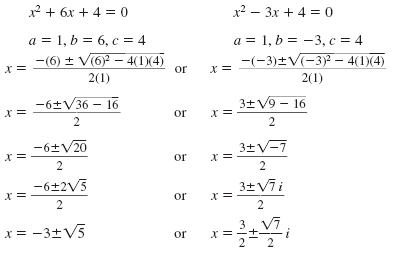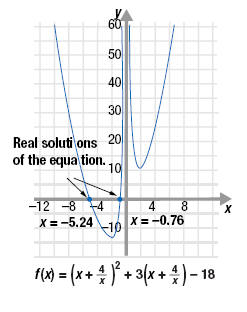Solving Nonlinear Equations by Substitution
Example
Solve for x:

| Solution |
 |
= 18 |
| Step 1 Write the equation in quadratic form. |
|
|
Subtract 18 from both sides. |
 |
= 0 |
| Step 2 Use an appropriate “u†substitution. Substitute u for
 |
u2 + 3u - 18 |
= 0 |
| Step 3 Solve the resulting equation.
Factor the new equation.
Use the Zero Product Property.
Solve each equation for u. |
(u + 6)(u - 3)
u + 6 = 0 or u - 3
u = -6 or u
|
= 0
= 0
= 3 |
| Step 4 Substitute the original
expression for u.
|
 |
= 3 |
| Step 5 Solve for the original variable.
Multiply both sides of each
equation by x.
Write each equation in standard form. |
x2 + 4 = -6x or x2 + 4
x2 + 6x + 4 = 0 or x2 - 3x + 4 |
= 3x
= 0 |
Neither equation factors. So, we will use the quadratic
formula to solve each:

So, there are four solutions:
 
The equation
 written
in standard form is written
in standard form is

The graph of the corresponding function,
 is shown.
is shown.

The graph crosses the x-axis at the two locations corresponding to the two
real solutions of the equation:

Note that x is in a denominator and so it cannot equal 0. Therefore, the line
x = 0 is a vertical asymptote.
|



